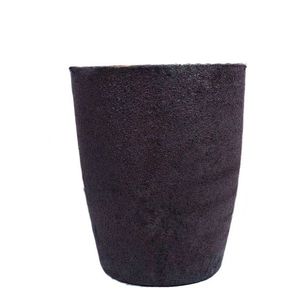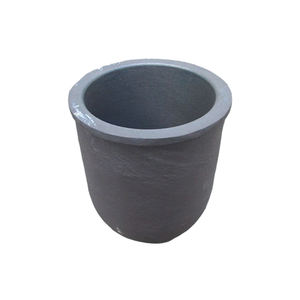1. Product Fundamentals and Structural Feature
1.1 Crystal Chemistry and Polymorphism
(Silicon Carbide Crucibles)
Silicon carbide (SiC) is a covalent ceramic made up of silicon and carbon atoms prepared in a tetrahedral latticework, creating among one of the most thermally and chemically durable materials understood.
It exists in over 250 polytypic kinds, with the 3C (cubic), 4H, and 6H hexagonal frameworks being most relevant for high-temperature applications.
The solid Si– C bonds, with bond energy exceeding 300 kJ/mol, provide remarkable solidity, thermal conductivity, and resistance to thermal shock and chemical strike.
In crucible applications, sintered or reaction-bonded SiC is chosen because of its capacity to keep architectural stability under extreme thermal gradients and harsh molten environments.
Unlike oxide ceramics, SiC does not go through disruptive phase shifts approximately its sublimation factor (~ 2700 ° C), making it ideal for sustained procedure above 1600 ° C.
1.2 Thermal and Mechanical Performance
A defining feature of SiC crucibles is their high thermal conductivity– varying from 80 to 120 W/(m · K)– which advertises uniform heat distribution and minimizes thermal stress and anxiety during quick heating or cooling.
This property contrasts sharply with low-conductivity porcelains like alumina (≈ 30 W/(m · K)), which are susceptible to fracturing under thermal shock.
SiC likewise displays exceptional mechanical toughness at raised temperatures, retaining over 80% of its room-temperature flexural stamina (approximately 400 MPa) even at 1400 ° C.
Its low coefficient of thermal development (~ 4.0 × 10 ⁻⁶/ K) further improves resistance to thermal shock, a vital factor in duplicated cycling between ambient and functional temperature levels.
Additionally, SiC demonstrates superior wear and abrasion resistance, ensuring lengthy service life in settings involving mechanical handling or turbulent thaw circulation.
2. Manufacturing Approaches and Microstructural Control
( Silicon Carbide Crucibles)
2.1 Sintering Techniques and Densification Techniques
Industrial SiC crucibles are primarily made through pressureless sintering, response bonding, or hot pushing, each offering distinctive benefits in cost, pureness, and efficiency.
Pressureless sintering entails compacting great SiC powder with sintering aids such as boron and carbon, complied with by high-temperature therapy (2000– 2200 ° C )in inert ambience to attain near-theoretical density.
This method yields high-purity, high-strength crucibles ideal for semiconductor and progressed alloy handling.
Reaction-bonded SiC (RBSC) is created by penetrating a permeable carbon preform with molten silicon, which responds to form β-SiC sitting, causing a composite of SiC and recurring silicon.
While slightly lower in thermal conductivity as a result of metallic silicon inclusions, RBSC supplies exceptional dimensional security and reduced production cost, making it prominent for large commercial usage.
Hot-pressed SiC, though a lot more costly, provides the highest possible density and purity, booked for ultra-demanding applications such as single-crystal growth.
2.2 Surface Area High Quality and Geometric Accuracy
Post-sintering machining, consisting of grinding and splashing, makes sure exact dimensional tolerances and smooth internal surface areas that lessen nucleation sites and reduce contamination threat.
Surface area roughness is thoroughly managed to avoid melt adhesion and facilitate very easy launch of solidified materials.
Crucible geometry– such as wall density, taper angle, and bottom curvature– is enhanced to balance thermal mass, structural strength, and compatibility with heater burner.
Custom-made designs fit particular melt volumes, heating accounts, and material sensitivity, ensuring optimum performance across diverse commercial processes.
Advanced quality assurance, consisting of X-ray diffraction, scanning electron microscopy, and ultrasonic screening, validates microstructural homogeneity and absence of flaws like pores or fractures.
3. Chemical Resistance and Communication with Melts
3.1 Inertness in Aggressive Settings
SiC crucibles exhibit remarkable resistance to chemical attack by molten metals, slags, and non-oxidizing salts, surpassing conventional graphite and oxide porcelains.
They are secure touching liquified light weight aluminum, copper, silver, and their alloys, standing up to wetting and dissolution due to reduced interfacial energy and formation of safety surface area oxides.
In silicon and germanium processing for photovoltaics and semiconductors, SiC crucibles prevent metal contamination that might break down electronic residential properties.
Nonetheless, under highly oxidizing problems or in the existence of alkaline fluxes, SiC can oxidize to develop silica (SiO TWO), which might respond even more to develop low-melting-point silicates.
For that reason, SiC is finest matched for neutral or reducing environments, where its stability is taken full advantage of.
3.2 Limitations and Compatibility Considerations
Regardless of its robustness, SiC is not universally inert; it responds with specific molten products, particularly iron-group steels (Fe, Ni, Co) at high temperatures with carburization and dissolution processes.
In molten steel processing, SiC crucibles break down quickly and are as a result stayed clear of.
Likewise, alkali and alkaline planet steels (e.g., Li, Na, Ca) can lower SiC, releasing carbon and developing silicides, restricting their usage in battery material synthesis or reactive metal spreading.
For liquified glass and ceramics, SiC is generally compatible however may introduce trace silicon into highly sensitive optical or electronic glasses.
Recognizing these material-specific communications is important for choosing the ideal crucible type and making certain process pureness and crucible longevity.
4. Industrial Applications and Technical Development
4.1 Metallurgy, Semiconductor, and Renewable Energy Sectors
SiC crucibles are important in the manufacturing of multicrystalline and monocrystalline silicon ingots for solar batteries, where they hold up against prolonged exposure to molten silicon at ~ 1420 ° C.
Their thermal stability guarantees uniform crystallization and lessens dislocation density, directly affecting solar efficiency.
In factories, SiC crucibles are made use of for melting non-ferrous steels such as aluminum and brass, offering longer service life and lowered dross development contrasted to clay-graphite alternatives.
They are likewise utilized in high-temperature research laboratories for thermogravimetric analysis, differential scanning calorimetry, and synthesis of innovative ceramics and intermetallic compounds.
4.2 Future Patterns and Advanced Material Assimilation
Arising applications consist of using SiC crucibles in next-generation nuclear products screening and molten salt reactors, where their resistance to radiation and molten fluorides is being evaluated.
Coatings such as pyrolytic boron nitride (PBN) or yttria (Y ₂ O FIVE) are being related to SiC surfaces to additionally boost chemical inertness and protect against silicon diffusion in ultra-high-purity procedures.
Additive production of SiC elements making use of binder jetting or stereolithography is under growth, appealing complicated geometries and quick prototyping for specialized crucible layouts.
As demand grows for energy-efficient, sturdy, and contamination-free high-temperature handling, silicon carbide crucibles will certainly continue to be a foundation innovation in sophisticated materials manufacturing.
In conclusion, silicon carbide crucibles represent an essential making it possible for component in high-temperature industrial and clinical procedures.
Their unrivaled combination of thermal stability, mechanical strength, and chemical resistance makes them the product of selection for applications where performance and dependability are extremely important.
5. Distributor
Advanced Ceramics founded on October 17, 2012, is a high-tech enterprise committed to the research and development, production, processing, sales and technical services of ceramic relative materials and products. Our products includes but not limited to Boron Carbide Ceramic Products, Boron Nitride Ceramic Products, Silicon Carbide Ceramic Products, Silicon Nitride Ceramic Products, Zirconium Dioxide Ceramic Products, etc. If you are interested, please feel free to contact us.
Tags: Silicon Carbide Crucibles, Silicon Carbide Ceramic, Silicon Carbide Ceramic Crucibles
All articles and pictures are from the Internet. If there are any copyright issues, please contact us in time to delete.
Inquiry us

